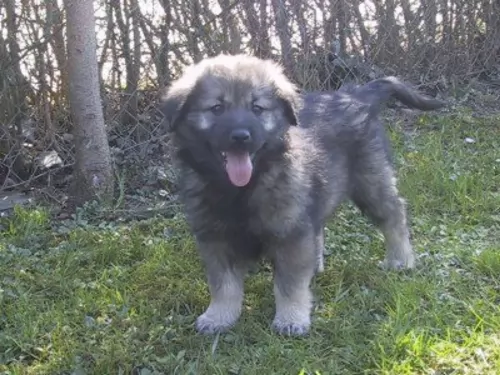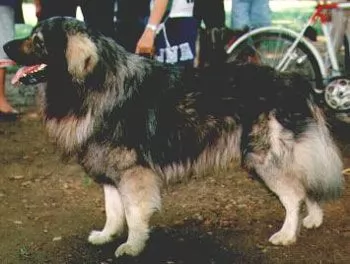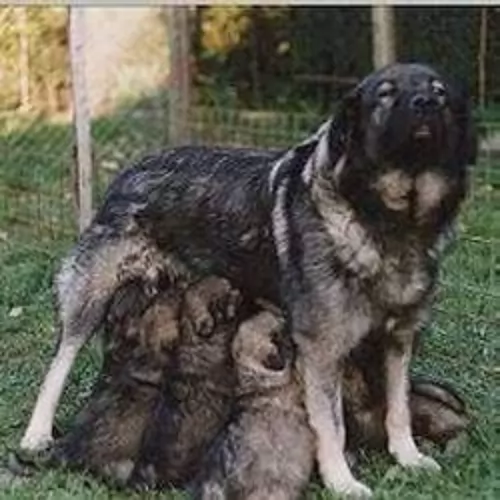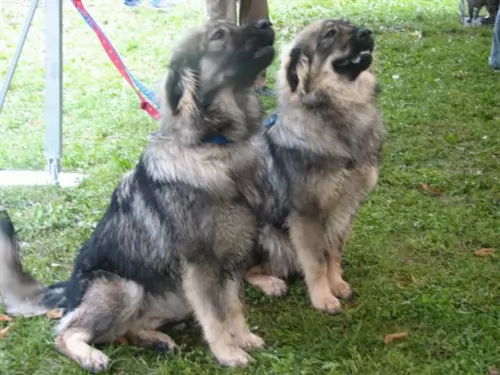 MyDogBreeds
MyDogBreeds Istrian Sheepdog is originated from Slovenia but Havanese is originated from Cuba. Istrian Sheepdog may grow 36 cm / 15 inches higher than Havanese. Istrian Sheepdog may weigh 34 kg / 75 pounds more than Havanese. Istrian Sheepdog may live 4 years less than Havanese. Istrian Sheepdog may have less litter size than Havanese. Istrian Sheepdog requires Moderate maintenance. But Havanese requires High maintenance
Istrian Sheepdog is originated from Slovenia but Havanese is originated from Cuba. Istrian Sheepdog may grow 36 cm / 15 inches higher than Havanese. Istrian Sheepdog may weigh 34 kg / 75 pounds more than Havanese. Istrian Sheepdog may live 4 years less than Havanese. Istrian Sheepdog may have less litter size than Havanese. Istrian Sheepdog requires Moderate maintenance. But Havanese requires High maintenance
 Known also as the Karst Sheepdog, the beautiful, medium sized Istrian Sheepdog hails from Slovenia, Yugoslavia in the 1600s, being used to guard sheep. In fact, the Karst Shepherd was recognized as the Illyrian Shepherd in 1939.
Known also as the Karst Sheepdog, the beautiful, medium sized Istrian Sheepdog hails from Slovenia, Yugoslavia in the 1600s, being used to guard sheep. In fact, the Karst Shepherd was recognized as the Illyrian Shepherd in 1939.
The dog is fairly scarce in his own country, but interest in the dog started developing in the late 1970s. The Fédération Cynologique Internationale recognizes the breed and it has also been exported to the United States, being recognized by the United Kennel Club.
It is also recognized by a number of smaller kennel clubs. The dogs numbers have declined at certain periods in its history but fortunately breeding programs boosted its numbers.
 The only breed of dog that is native to Cuba is the Havanese. These little dogs are great companion animals. Sociable and happy, they are very popular in the United States with urbanites. These happy little pups are a Bichon type of dog which was developed from the “Little White Dog of Havana” or the Blanquito de la Habana which is now extinct.
The only breed of dog that is native to Cuba is the Havanese. These little dogs are great companion animals. Sociable and happy, they are very popular in the United States with urbanites. These happy little pups are a Bichon type of dog which was developed from the “Little White Dog of Havana” or the Blanquito de la Habana which is now extinct.
The Blanquito de la Habana was itself developed from another extinct breed the Bichon Tenerife. Then the Blanquito was bred with the other Bichons and poodles in developing the Havanese. It is believed that some of the first people to settle in Cuba were from Tenerife, an island close to Cuba. In the early part of the sixteenth century, little white dogs were brought to Cuba with these settlers. This dog of Tenerife is believed to be the ancestor of all Bichon breeds.
At that time trade with Cuba was highly restricted by the Spanish and so these dogs developed without any crossing from other breeds from outside the country. They grew to be able to stand hot temperatures and they grew a very unique coat – almost like silk. Their coat is soft and light, while insulating them from the tropical environment.
At this time Cuba was the place to be for Europeans aristocrats on vacation. Unlike the British colonies, Cuba had theatres, operas and palacious. When going back to Europe, many took this little white dog with them to France, Spain and England. The Dog of Havannah was a favorite on European soil as well. Many of these dogs taken to Europe were fawn or parti instead of white. Meanwhile back in Cuba, the bourgeoisie were replacing the aristocracy who themselves would soon be replaced by the Revolution.
During the days of the bourgeoisie, the Havanese became very popular household pets. The breed has been a family pet for the last 150 years. At the same time the breed was very trendy in Europe with Charles Dickens and Queen Victoria owning several. They were by now familiar participants in Europe’s dog shows. Finally, with the Revolution, the bourgeoisie left the country in droves with their little white dogs. A genetic pool was then formed in the US. Gene pool from 11 dogs. All the Havanese in the world are descended from those 11 dogs with the exception of the dogs isolated in Cuba and the US. Today the Havanese is one of the most popular and fastest growing breeds in the world.
 This is a medium sized, muscled, strong dog with an iron-grey coat that has shades of deeper grey. His beautiful coat is long, thick and fairly harsh to the touch, with the undercoat protecting the dog against cold weather.
This is a medium sized, muscled, strong dog with an iron-grey coat that has shades of deeper grey. His beautiful coat is long, thick and fairly harsh to the touch, with the undercoat protecting the dog against cold weather.
Around the neck area the hair is longer, forming an eye-catching-like mane. The stomach area has longer hair too. He has a noble look about him with kind, brown eyes and a round skull. The muzzle of the dog is dark, the limbs long and muscular and the tail is long and covered in thick fur.
The dog is slightly longer than its height, and both males and females stand at 54 to 63cm in height and weigh between 26 and 40kg. The long tail reaches right down to the hocks. The ears of the dog are fairly short and are floppy.
This dog has always made an excellent guard dog, being alert and also being distrustful of strangers. He will need to be trained and socialized if you want him to be obedient to you and more amicable around children in the home as well as visitors to the home.
If he is trained and well socialized, he is able to make a good pet. However, he is an energetic dog, used to working and he isn't recommended for life in the city if there is only a tiny garden. He needs space and will require a large garden.
He will also need to be exercised and not just left to his own devices in the backyard. Because he is essentially a working dog he doesn’t easily fit into the role of pet and companion. He is a working dog and will need to be kept busy.
 The Havanese is a sturdy little dog, a member of the toy group. They weigh no more than 16 pounds (7.3kg) and his body is longer than it is tall. The breed has a unique topline that is not level, but it is straight. His front legs are longer than his hind legs producing the lively gait everyone is used to seeing with a Havanese. With a full muzzle that tapers to the nose, the Havanese does not seem to be short. The skull’s length is the same as the muzzle’s. The head of the Havanese is round in the back and flat in the front.
The Havanese is a sturdy little dog, a member of the toy group. They weigh no more than 16 pounds (7.3kg) and his body is longer than it is tall. The breed has a unique topline that is not level, but it is straight. His front legs are longer than his hind legs producing the lively gait everyone is used to seeing with a Havanese. With a full muzzle that tapers to the nose, the Havanese does not seem to be short. The skull’s length is the same as the muzzle’s. The head of the Havanese is round in the back and flat in the front.
They have a deep chest, almond shaped eyes that are dark brown and their ears are about halfway down the nose. The long ears hang down the side od the face. They have a long plumed tail that is held high and upward. The standard for the breed and now the laws of the United Kingdom state that there can be no docking of the tail.
 Your Istrian Sheepdog is a unique, strong-willed dog that is used to guarding, and working and he wants to be kept involved and busy.
Your Istrian Sheepdog is a unique, strong-willed dog that is used to guarding, and working and he wants to be kept involved and busy.
He is wary of strangers and makes an excellent guard dog for any family home. Remember that it is never good to invest in a dog purely for guard dog purposes. A dog such as the Istrian Sheepdog is a social creature and he also wants- and needs to be part of a human family that provides him with plenty of interaction with them.
The Istrian Sheepdog is a loyal, loving dog who is capable of forming strong bonds with his human family. With proper training and socialization he makes a good friend of children and the elderly too.
Include him in all your family activities just like any human family member and he will make you a splendid, courageous pet.
 Havanese are highly intelligent and eager to please, and they are easily trained so long as you use only positive methods. This can be a sensitive breed, so care must be taken to not scold them harshly. Socialization from an early age is very important. Expose them calmly to a wide variety of new places and new people, always ensuring that the experiences are positive and not intimidating. Gentle, patient training will result in a wonderful companion dog. They are affectionate with people and get along with other nonaggressive pets.
Havanese are highly intelligent and eager to please, and they are easily trained so long as you use only positive methods. This can be a sensitive breed, so care must be taken to not scold them harshly. Socialization from an early age is very important. Expose them calmly to a wide variety of new places and new people, always ensuring that the experiences are positive and not intimidating. Gentle, patient training will result in a wonderful companion dog. They are affectionate with people and get along with other nonaggressive pets.
The Havanese is the consummate lap dog. Over time they have become the lovable family companion.
The breed is pretty adaptable being able to live as a companion animal in almost any setting. Just don’t expect your Havanese to go hiking or romp with you on 40 acres in the country.
They are intelligent, love to learn but can be a little stubborn. Train them early as they like their habits and its much harder to train an older Havanese.
 As with many other dog breeds, the Istrian Sheepdog is a healthy dog that, because of history of hard work, is robust and able to stand up well to common dog illnesses.
As with many other dog breeds, the Istrian Sheepdog is a healthy dog that, because of history of hard work, is robust and able to stand up well to common dog illnesses.
However there is one dog illness that strikes many dogs and at any age, and it is hip dysplasia. This is a malformation of the hip joints.
You'll notice that your once active dog is lethargic, doesn't want to play so much anymore and battles to get up after lying down. The disease is painful for your dog and it can lead to mobility issues. The disease is diagnosed with x-rays and your vet will recommend treatment options to make life more comfortable and less painful for your beloved pet.
 A very healthy breed, the Havanese doesn’t have a lot of health issues, but they are not immune to the problems of small breed dogs. The issues they do have are:
A very healthy breed, the Havanese doesn’t have a lot of health issues, but they are not immune to the problems of small breed dogs. The issues they do have are:
 This is a dog that is used to guarding his flock and he will need to be in a home that has a fair sized garden. He can adapt to life in the city or to the countryside, but wherever he is, he will need sufficient exercise. Take him with you on your walks or hikes and give him some rope- and ball games.
This is a dog that is used to guarding his flock and he will need to be in a home that has a fair sized garden. He can adapt to life in the city or to the countryside, but wherever he is, he will need sufficient exercise. Take him with you on your walks or hikes and give him some rope- and ball games.
Wherever you live in the world, when the Winter winds howl and blow in icy rain or snow, a dog is at an increased risk of illness. You decided to have a dog in your home and it is your responsibility to care for him. Winter weather is downright unpleasant and dangerous for most pets.
Bring your pet in during such weather and provide him with a warm, dry sleeping space. During hot weather, make sure your pet has a cool, shady spot to lie down in, out of the boiling sun. Whatever weather you're experiencing, your pet should never ever be without a constant supply of fresh, cool water.
Provide him with excellent food that is full of vitamins and minerals to keep him healthy. Learn to know what human foods can be toxic for him and cause him digestive problems.
Your double coated Istrian Sheepdog will need a thorough brushing at least twice a week because of his dense, double coat. He does shed and isn't a hypoallergenic dog. His thick coat can tangle easily if it isn't properly brushed and maintained.
Clip his nails when and if they grow long. Other grooming aspects for this attractive dog require checking his ears for infection and also checking his teeth as dental disease can lead to a host of serious illnesses in your dog.
 Feed 3 to 4 times per day a high quality dry puppy food for toy or small dogs. Feed ¼ to ½ cup each time.
Feed 3 to 4 times per day a high quality dry puppy food for toy or small dogs. Feed ¼ to ½ cup each time.
Remember these are small dogs and don’t overfeed. Feed a high quality dry food for small or toy dogs. Feed twice a day at about ½ cup each time.
The breed is generally very healthy.
This breed is not an overly active dog, but he does need some exercise. A nice walk once a day or a backyard to play in. They play inside as well as out. Don’t over exercise the Havanese. They do well in obedience and confirmation more so than agility or fly ball